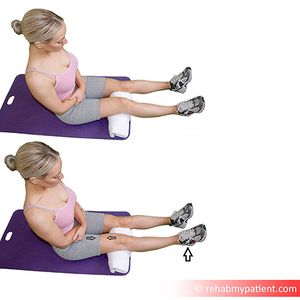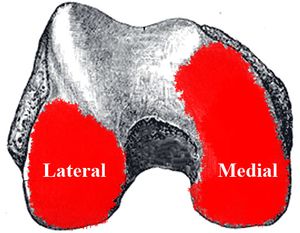Screw Home Mechanism of The Knee Joint: Difference between revisions
No edit summary |
No edit summary |
||
| Line 20: | Line 20: | ||
* During knee extension, tibia rolls anteriorly, elongating the PCL and the PCL’s pull on tibia, causes it to glide anteriorly. | * During knee extension, tibia rolls anteriorly, elongating the PCL and the PCL’s pull on tibia, causes it to glide anteriorly. | ||
* During knee flexion tibia rolls posteriorly, elongating the ACL and it is the ACL’s pull on tibia, that causes it to glide posteriorly. | * During knee flexion tibia rolls posteriorly, elongating the ACL and it is the ACL’s pull on tibia, that causes it to glide posteriorly. | ||
* Popliteus | * Popliteus - unlocks knee with open chain motions | ||
* Hip external rotation | * Hip external rotation - unlocks knee with closed chain motions<ref>Epomedicine [https://epomedicine.com/medical-students/screw-home-mechanism/ Screw home mechanism] Available from:https://epomedicine.com/medical-students/screw-home-mechanism/ (last accessed 12.9.2020)</ref>. | ||
=== Clinical Manifestations of Screw Home Mechanism === | === Clinical Manifestations of Screw Home Mechanism === | ||
| Line 38: | Line 38: | ||
* External rotation occurs during the terminal degrees of knee extension and results in tightening of both cruciate ligaments, which locks the knee. | * External rotation occurs during the terminal degrees of knee extension and results in tightening of both cruciate ligaments, which locks the knee. | ||
* The tibia is then in the position of maximal stability with respect to the femur<ref>Orthopaedicsone [https://www.orthopaedicsone.com/display/Main/Screw-home+mechanism Screw home mechanism] Available from:https://www.orthopaedicsone.com/display/Main/Screw-home+mechanism (last accessed 12.9.2020)</ref>. | * The tibia is then in the position of maximal stability with respect to the femur<ref>Orthopaedicsone [https://www.orthopaedicsone.com/display/Main/Screw-home+mechanism Screw home mechanism] Available from:https://www.orthopaedicsone.com/display/Main/Screw-home+mechanism (last accessed 12.9.2020)</ref>. | ||
The "screw home" mechanism describes the motion between the femur and tibia in the terminal extension (0-30 degrees) | |||
occurs because the medial femoral condyle is larger, so lateral structures (femoral condyle, meniscus) are congruent sooner with extension | |||
open chain: tibia externally rotates on femur in terminal extension | |||
closed chain: femur internally rotates on the tibia in terminal extension | |||
popliteus - unlocks knee with open chain motions | |||
hip external rotation - unlocks knee with closed chain motions | |||
Medial tibial condyle is longer than lateral tibial condyle. The medial femoral condyle will be moving longer than lateral condyle and will slide further posterior. This is responsible for the screw home mechanism of the knee or functional locking of the knee. The femur rotates internally to lock into extension (closed kinetic chain) The function of the popliteus muscle is to unlock the knee when standing. Adding to this concept is the fact that hip extension pulls the iliofemoral ligament tight, which can cause the last 20 degrees of knee extension, in absence of quadriceps action. A hip joint that is lacking extension will significantly impair knee extension/locking. | |||
In most of the knee problems generally there is an insufficiency on terminal extension and vastus medialis obliquus function. Restoration of terminal extension is an important goal of rehabilitation program. Terminal extension exercises like interventions have important contribution on restoration of screw home movement /terminal extension. | In most of the knee problems generally there is an insufficiency on terminal extension and vastus medialis obliquus function. Restoration of terminal extension is an important goal of rehabilitation program. Terminal extension exercises like interventions have important contribution on restoration of screw home movement /terminal extension. | ||
== References == | == References == | ||
<references /> | <references /> | ||
Revision as of 07:35, 12 September 2020
Definition[edit | edit source]
Screw home mechanism (SHM) of knee joint is a critical mechanism that play an important role in terminal extension of the knee.
- There is an observable rotation of the knee during flexion and extension.
- This rotation is important for healthy movement of the knee.
- During the last 30 degrees of knee extension, the tibia (open chain) or femur (closed chain) must externally or internally rotate, respectively, about 10 degrees.
- This slight rotation is due to inequality of the articular surface of femur condyles.
- Rotation must occur to achieve full extension and then flexion from full extension.[1][2][3][4][5][6].
Relevant Anatomy[edit | edit source]
The knee joint is basically a hinge joint with the main movement of flexion-extension. However, the radius and the length of the articular surface of the femur and tibia differ at the knee joint ie Articular surface of medial condyle of femur is greater than the articular surface of later condyle.
- As a result, a complex movement (includes "sliding") occurs during the last 30 degrees of knee extension, in addition to rolling between the two bones this allows the knee joint to move smoothly.
- At terminal extension, the knee joint is slightly hyperextended and stabilized with the tightening of the cruciate and collateral ligaments.
- As the length of the medial femoral condyle is longer than the length of the lateral condyle, the tibia rotates externally about 15° on the femur during the last 20° of extension.
- This kinematic phenomenon is well known, and it is called the screw-home movement
The shape of the condyles are not what brings about the movements.
- Tibial-on-femoral rotation occurs in an open chain exercise like in the leg extension machine (tibia externally rotates).
- Femoral-on-tibial rotation, as in a closed chain exercise like the squat (femur internally rotate).
- During knee extension, tibia rolls anteriorly, elongating the PCL and the PCL’s pull on tibia, causes it to glide anteriorly.
- During knee flexion tibia rolls posteriorly, elongating the ACL and it is the ACL’s pull on tibia, that causes it to glide posteriorly.
- Popliteus - unlocks knee with open chain motions
- Hip external rotation - unlocks knee with closed chain motions[7].
Clinical Manifestations of Screw Home Mechanism[edit | edit source]
Terminal Knee Extention Exercise[edit | edit source]
Terminal knee extention is a specific exercise for vastus medialis obliquus muscle. In earlier descriptions of the exercise it is sugested to improve muscle force of vastus medialis obliquus. Further descriptions also focused on motor leraning and vastus medialis obliquus time delay during terminal extention.

Clinical Relevelance[edit | edit source]
The "screw-home" mechanism is considered to be a key element to knee stability for standing upright.
The tibia rotates internally during the swing phase and externally during the stance phase.
- External rotation occurs during the terminal degrees of knee extension and results in tightening of both cruciate ligaments, which locks the knee.
- The tibia is then in the position of maximal stability with respect to the femur[8].
The "screw home" mechanism describes the motion between the femur and tibia in the terminal extension (0-30 degrees)
occurs because the medial femoral condyle is larger, so lateral structures (femoral condyle, meniscus) are congruent sooner with extension
open chain: tibia externally rotates on femur in terminal extension
closed chain: femur internally rotates on the tibia in terminal extension
popliteus - unlocks knee with open chain motions
hip external rotation - unlocks knee with closed chain motions
Medial tibial condyle is longer than lateral tibial condyle. The medial femoral condyle will be moving longer than lateral condyle and will slide further posterior. This is responsible for the screw home mechanism of the knee or functional locking of the knee. The femur rotates internally to lock into extension (closed kinetic chain) The function of the popliteus muscle is to unlock the knee when standing. Adding to this concept is the fact that hip extension pulls the iliofemoral ligament tight, which can cause the last 20 degrees of knee extension, in absence of quadriceps action. A hip joint that is lacking extension will significantly impair knee extension/locking.
In most of the knee problems generally there is an insufficiency on terminal extension and vastus medialis obliquus function. Restoration of terminal extension is an important goal of rehabilitation program. Terminal extension exercises like interventions have important contribution on restoration of screw home movement /terminal extension.
References[edit | edit source]
- ↑ Goodfellow J, O'Connor J. The mechanics of the knee and prosthesis design. J Bone Joint Surg Br. 1978;60(3):358–369.
- ↑ Bytyqi D, Shabani B, Lustig S, Cheze L, Karahoda Gjurgjeala N, Neyret P. Gait knee kinematic alterations in medial osteoarthritis: three dimensional assessment. Int Orthop. 2014;38(6):1191–1198.
- ↑ Ishii Y, Terajima K, Terashima S, Koga Y. Three-dimensional kinematics of the human knee with intracortical pin fixation. Clin Orthop Relat Res. 1997;(343):144–150.
- ↑ https://www.ncbi.nlm.nih.gov/pubmed/12135550
- ↑ Asano T, Akagi M, Tanaka K, Tamura J, Nakamura T. In vivo three-dimensional knee kinematics using a biplanar imagematching technique. Clin Orthop Relat Res. 2001;(388):157–166
- ↑ Kim, H. Y., Kim, K. J., Yang, D. S., Jeung, S. W., Choi, H. G., & Choy, W. S. (2015). Screw-Home Movement of the Tibiofemoral Joint during Normal Gait: Three-Dimensional Analysis. Clinics in orthopedic surgery, 7(3), 303–309. doi:10.4055/cios.2015.7.3.303
- ↑ Epomedicine Screw home mechanism Available from:https://epomedicine.com/medical-students/screw-home-mechanism/ (last accessed 12.9.2020)
- ↑ Orthopaedicsone Screw home mechanism Available from:https://www.orthopaedicsone.com/display/Main/Screw-home+mechanism (last accessed 12.9.2020)







